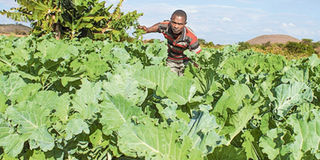Sand harvesters turn prolific crop growers

Former sand-harvester, Peter Musembi weeds vegetables that he now grows in his farm in Makueni County. He is among former sand-harvesters who have now become champions of river conservation. PHOTO | PIUS MAUNDU | NMG
What you need to know:
- The father of four is among young people who farm all year round using water collected in a shallow well next to the river, where they previously harvested stand.
- The former sand harvesters have now become champions of river conservation. The sand harvesting trade started in the 1980s.
- Makueni County Sand Conservation and Utilisation Authority managing director Halinishi Yusuf singles out building of sand dams and the involvement of communities as some of the strategies the devolved unit used to address the menace.
- Small farming communities have sprouted around the installed sand dams. Julius Muli’s farm on the fringes of Wautu market serves as a model farm where new farmers go for farming lessons.
Ngila Kiema paces expertly across rows of healthy sukuma wiki plants scouting for pests and diseases on his farm in Makueni County.
Not long ago, the 35-year-old was scooping sand in Muuoni River and loading it onto trucks for a living. He has now shifted to growing vegetables on a small plot on the banks of the river, which pass near Emali township in Makueni.
The father of four is among young people who farm all year round using water collected in a shallow well next to the river, where they previously harvested stand.
The water is pumped from the well using a diesel-powered generator. “We started small by drawing the water using buckets before buying the machine and hose pipes,” says Peter Musembi.
The youthful farmers manage the small farms in such a way that they produce vegetables at any time of the year.
When they are not tending to their farms, the farmers are selling vegetables to their neighbours and retailers in Emali town.
“On average, I make Sh1,500 daily from selling vegetables,” says Mr Kiema. “This has been our occupation for the past six years following efforts to recover the seasonal river, which had been destroyed by years of wanton sand harvesting.”
The former sand harvesters have now become champions of river conservation. The sand harvesting trade started in the 1980s.
A construction company that had landed a deal to build government offices in Wote town descended on Muooni River with multiple excavators and trucks.
Extensive sand mining eventually created canyons on the two rivers’ beds and introduced locals to sand trade.
LOST THE BATTLE
So lucrative was the trade that it spawned loaders, middlemen and transporters. Youths dropped out of school to make quick money by loading trucks. They drove the lorries through farmlands into river beds teeming with the commodity.
Residents opposed to sand harvesting clashed with the harvesters but often lost the battle.
“It once took us half a day to fill a truck, which normally took minutes. We realised that we had destroyed the river and that it was time to look for an alternative source of livelihood. That is how the sand business ended,” Mr Kiema says.
Makueni County Sand Conservation and Utilisation Authority managing director Halinishi Yusuf singles out building of sand dams and the involvement of communities as some of the strategies the devolved unit used to address the menace.
“We work closely with communities to identify appropriate points in the affected rivers where we can install sand dams,” she says.
The dams trap sand and thus hold water, which can later be accessed by communities for various uses.
“The coarser the sand trapped in a sand dam, the more the amount of surface runoff the dam traps,” says Mr Erik Nissen-Petersen, an expert on rain-water harvesting systems.
Small farming communities have sprouted around the installed sand dams. Julius Muli’s farm on the fringes of Wautu market serves as a model farm where new farmers go for farming lessons.
Muli grows French beans, onions, sukuma wiki, cabbages and maize on Zai pits installed across his six-acre farm.
Just like Kiema, Mr Muli took up micro-irrigation farming three years ago after he stopped harvesting sand.





